The Ford Ranger is back – and it’s much bigger.
The formerly compact pick-up (which was last available in the U.S. back in 2011) returns for the 2019 model year after many trips to the all-you-can-eat buffet. It is now nearly as big as the F-150 (Ford’s full-size truck) used to be.
It is just as tall – 72 inches vs. 72.7 for the circa 2000 F-150 – and much wider – an astounding 85.8 inches at the hips vs. 79.3 inches for the 2000 F-truck (and 69.3 inches for the old Ranger).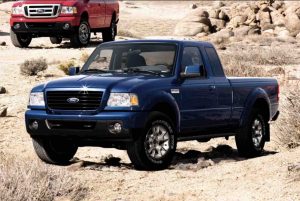
It also uses only slightly less gas.
The new, much-less-compact Ranger is rated 21 city, 26 highway with 2WD and 20 city, 24 highway with 4WD while the 2000 F-150 managed 15 city, 19 highway.
This in spite of the new Ranger having a much smaller engine (2.3 liters and four cylinders vs. the 2000 F-truck’s standard 4.2 liters and six cylinders) that is also direct-injected (the 2000 F-truck’s engine was merely port fuel-injected, a much simpler system) and paired up with a ten-speed automatic transmission that has three overdrive gears – vs. just the one overdrive gear inside the 2000 F-150’s five-speed manual (or four speed automatic) transmission.
You do get much more horsepower – 270 vs. 205 for the old truck’s V6 – because the new truck’s little engine is heavily turbocharged.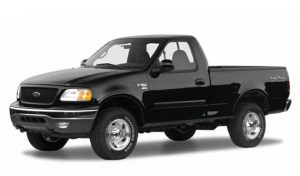
But the mileage gains vs. a full-sized truck are not much more than a toss-up, despite all the technology – because the new Ranger is a much larger and much heavier Ranger than the actually compact Ranger Ford used to make.
The lightest version – with 2WD – weighs 4,232 lbs. The heaviest – with 4WD – weighs 4,441 lbs.
The previous Ranger weighed 1,204 lbs. less for the 2WD version (3,028 lbs.) and 835 lbs. less with 4WD.
In part, because the new Ranger will be sold only in four-door form – either extended SuperCab or SuperCrew, the latter with four full-size doors and the former with smaller ones.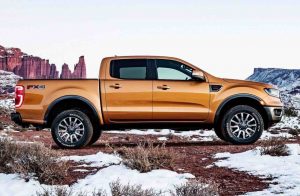
The old Ranger was available with a regular cab and came standard with a six-foot bed; the new model comes standard with a five-foot bed.
You could opt for a seven-footer, too – which enabled the physically smaller old Ranger to carry more stuff in its bed with the tailgate closed than the new Ranger can with its optional six-foot bed withe gate down.
And even with the optional seven-foot bed, the old Ranger was still almost a foot shorter end to end (189.4 inches) than the new Ranger is with the short bed (210.8 inches.) Which made it much easier to park the old Ranger as well as make U-turns without having to stop, reverse, make adjustments and then continue.
The old truck’s turning circle was a tight 37.7 inches for the regular cab iteration. The new truck’s turning circle with the mandatory four-door cab is 41.9 inches.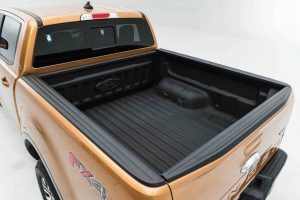
The old Ranger also delivered almost exactly the same mileage as the new one, too – 22 city, 27 – albeit with much less horsepower (143) but without the cost/complexity-adders of a turbocharger or a ten-speed transmission.
It wasn’t as powerful – or as capable.
But it was reasonably fuel-efficient.
And it was a truck.
The new Ranger is more of an SUV with a vestigial bed. It seems to have been designed mainly for carrying passengers (and labrador retrievers) rather than cargo. To be recreational rather than occupational.
This is not a criticism, per se, because it is apparently what the market wants. Or at least, it is what Ford thinks the market wants.
It appears there is no longer a market for a compact truck with a proportionately large bed; a truck that doesn’t need a direct-injected engine or a ten-speed transmission to get over the 20 MPG hump. Or a turbocharged, direct-injected engine to make the power necessary to haul around 4,000-plus pounds of truck – before anything is put in the bed.
But the end result is so close to being full-sized in fact that the only reason it’s not formally considered that is because today’s full-size models are super-sized. They make the full-size trucks of the recent past seem almost DeVito-esque next to their jacked and stacked Arnoldness.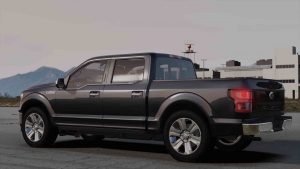
A 2019 F-150 SuperCrew (four full-size doors) with a short (6.5 foot) bed stretches from Dearborn to Hermosillo, Mexico – almost. This one is 243.7 inches. Which is some two feet longer than a 2000 model F-truck with an eight-foot bed.
And the new F-truck is Gulliverian in other proportions: 77.3 inches tall, with bedwalls so high a six-foot man can’t lay his palm flat on the bed floor – and might not be able to touch it at all – without standing on a milk crate.
If you have the opportunity to view a circa 2000 full-size pick-up parked next to a current full-size truck . . . or the new Ranger parked alongside the old one – you will be astounded by the growth spurt.
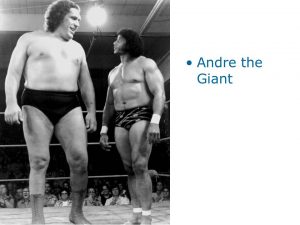
It’s a kind of vehicular acromegaly, the pituitary aberration which afflicts some unfortunate humans with giantism. Like Andre the Giant, for instance. And Ted Cassidy – Lurch from The Addams Family.
It’s what people want, it seems. Supersize everything – from waistlines to trucks.
One wonders, though, how Ford will manage to continue selling this upsized, not-very-fuel-efficient Ranger under a regime that demands even trucks average almost 50 MPG just five years from now.
A compact-sized Ranger with a diesel might have at least gotten two-thirds of the way there.
But we can’t have compacts – because of something called the “chicken tax” (see here). This is why I italicized appears in relation to what the market (may or may not) actually want earlier in this rant.
And while Ford does offer a diesel-powered version of the new and upsized Ranger, it probably won’t offer it here.
Because although the government pretends to care about gas mileage, it does all it can to stymie it by (effectively) outlawing high-efficiency diesels and also by force-bloating vehicle design for the sake of “safety” – which is a gross misnomer, since what we’re really talking about is how a vehicle deals with a crash, nor whether it is more likely to crash.
So we get bigger, thirstier – and more expensive.
Because that’s how Uncle rolls.
. . .
Got a question about cars – or anything else? Click on the “ask Eric” link and send ’em in!
If you like what you’ve found here please consider supporting EPautos.
We depend on you to keep the wheels turning!
Our donate button is here.
If you prefer not to use PayPal, our mailing address is:
EPautos
721 Hummingbird Lane SE
Copper Hill, VA 24079
PS: Get an EPautos magnet (pictured below) in return for a $20 or more one-time donation or a $5 or more monthly recurring donation. (Please be sure to tell us you want a sticker – and also, provide an address, so we know where to mail the thing!)
My latest eBook is also available for your favorite price – free! Click here. 


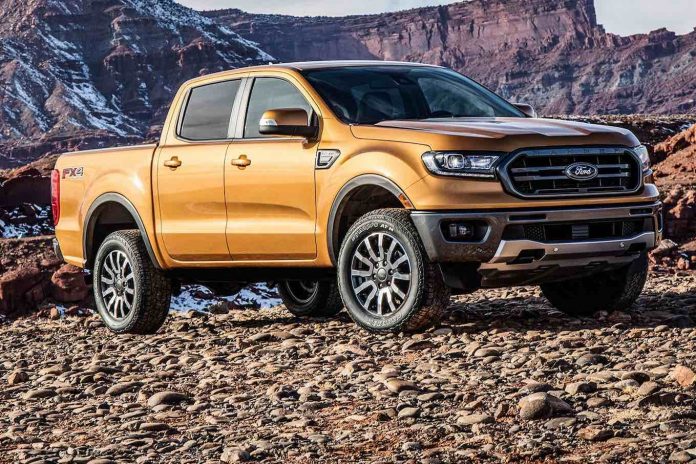










I own a 2004 Ranger XLT Super Cab with the 4.0L SOHC V6 and 5 Speed Auto. On summer gas, I can squeeze out around 20.6 mpg on the highway on a good day. The truck has been very reliable, and as of this writing, only 101k ish miles on it. I just hope I never have to do a timing job on it. They are the most difficult engine in the Ford family to do a timing job on. But yeah, I bet if I put my truck next to the new one, it would look comical. The “new” Ranger isn’t technically new if you merely go on the fact that it is built from the overseas Ranger. That truck has been selling for several years overseas. This “new” Ranger brought to the U.S. is tweaked for the U.S. market, including steel bumpers, and all the mandated Uncle saaaaaaaaaaaaaaaaaaaaaaftttttttttttttteeeeeeeeeeeeeeeeeyyyyyyyyyyyyy junk. And of course the power train is completely different. They get diesels overseas while we get garbage small block turbo engines and complicated 10 speed auto transmissions.
So grateful you pointed out the vestigial bed of the Ranger. I moved to New Zealand from Detroit five years ago and was amazed to find that almost none of the pickups in this country have proper beds (and you can just forget about long beds). Unless the pickup was imported, it seems your options are vestigial bed, or cut-away cabs with some sort of custom flat bed.
There’s a 1998 F150 Lariat for sale not very far from us with a full bed and in great shape. $16,000 is the asking price! I used to buy my trucks at auction and never paid more than $3000 for trucks in similar shape.
Looks like I may have buy a truck overseas and import it to get a proper bed at a reasonable price.
That’s why the Jeep Gladiator is so interesting. It too is a large “mid size.” It’s even longer than the Ranger, though I think that the Wrangler based design makes it feel smaller.
When it was revealed, Jeep made a point of hammering that you could reach in and touch the bed bottom standing alongside.
However, the Gladiator isn’t designed for work either. Jeep is explicitly marketing it as a “lifestyle” truck. It too has a 5′ bed and would look really awkward with anything longer.
And yet it has a higher tow capacity than anything in the segment except the GM twins in diesel/2wd form, and has a unique “half open” tailgate position to facilitate carrying 4×8 material.
It looks like it would be quite capable for work, relatively speaking, but the catch will be price. Before his death, Marchionne had said that the Gladiator will be “expensive, intentionally so.” Leaks indicated a $2500 premium over the Wrangler, which would put a base model at nearly $37,000. Max tow package would be additional.
Hi Freak,
Yup; my sources tell me the base MSRP will be around $38k – which (to me) makes it unaffordable. That almost $40k Jeep would also cost me (in VA) about $1,000 annually in property taxes for several year plus another $800 or so for the insurance mafia. So, leaving aside the cost of the Jeep itself, it would cost me at least $5,000 over five years to just park it in the driveway – before even putting gas in it. Put gas in it and spend money on tires and so on for it and now it’s $50k-plus down the hole… for a Wrangler with a bed.
Nein, danke.
I’ll keep my ’02 Frontier, which I bought used for $7,100 and which is still worth about $4,000 and which the government only rapes me about $100 annually for and which the mafia only sticks me up about $205 for…
I shudder to think about how expensive the rumored “Hercules” variant, supposedly a Raptor fighter, will cost.
Tim Kuniskis is now the head of Jeep. He was at Dodge when they brought to market the Hellcat and Demon. So I would expect something hot under the hood.
But Jeep says that while they can fit a HEMI, it won’t pass crash tests due to no crush space.
So the turbo I-6 that is slated for the Wagoneer and Grand Cherokee, and is supposed to make hemi power, might be the choice.
Watching a towing review of the Ranger and Tacoma I learned that they both have a similar track width and the mirrors are large for towing. 20″ of that overall width comes from the ranger having mirrors and housings that are at least 10″ each.
Eric,
Does one really have to remove a wheel to gain access to the oil filter?
Hi T,
That could be!
I haven’t worked on one of these, so can’t say. I will say, though, that I have to raise the passenger side of my ’02 Nissan Frontier – to let the passenger side front wheel hang free – in order to gain the necessary clearance/access to remove/install the oil filter.
There are probably other ways of doing this, but this works best in my experience! With the wheel hanging free, you have direct, line-of-sight access to the filter. I can reach my arm through the wheelwell and (usually) do it by hand.
Oil and filter changes have actually become somewhat easier in late model cars, in my experience. The filters especially are placed in more accessible locations and sometimes you hardly even need tools to remove them.
The one caveat being that many new cars also have “belly pans” that have to be removed before you can get at the oil drain plug!
No. That story has since been corrected. The wheel doesn’t need to be removed, but it does need to be turned hard over to get the access panel off.
What was the point, Ford ?
This truck is like a less useful version of my “work truck” — a Toyota Highlander SUV with some old blankets I spread out in the back when I have to haul something dirty for my yard work.
The “small” truck segment seems like it is a jack of all trades, master of none. I really wanted to like these when I was shopping for the TDI replacement. But the Tacoma was way too expensive, and being an official vehicle of the outdoorsy Coloradian they’re not budging on price. The Nissan was priced right but had a cheep feel (and I had to beg the sales people for help, but that’s more a problem with the dealer). The Honda Ridgeline was the closest to what I wanted but I wasn’t impressed with the new design and the used ones are too expensive. Chevy Colorado was probably the best of the lot, especially with the diesel, but one of the main drivers for the back seat was my aging parents and no way mom could climb in without a lot of assistance. So I went the SUV route with the Cherokee and I’m pretty happy with that decision. I don’t find I need the compromised truck bed anyway and if I do it’s a simple matter to borrow/rent/buy an open trailer.
BTW the reason for the high sides on the beds is twofold: first it gets them a better cargo hauling dimension, so instead of a 4X8 bed they can add height and suddenly more Cu in! Second I’m pretty sure it improves aerodynamic performance. And for sure the ground clearance* and cartoonishly large wheels/tires are the reason for height off the ground. Again, another checkbox number for the marketing team.
*Always have to laugh at the guys who install aftermarket rear differentials on their F-150 that would be dragging on the ground if they had normal tires. Buy a truck with a ton of ground clearance, then put a shiny new (high dollar) rear diff in so you can scrape it on the rocks. Then jack up the suspension, oversize the tires and waste all that torque you chipped just to get the thing moving. And use the bed to haul around the step stool so the GF can get in.
I always get a chuckle about the Ford 4x4s of the 1960s/1970s that sat so ridiculously high just as they came from the factory, and around 1980 they finally figured out how to get them down to a more reasonable height like Chevy/GMC, Dodge, and Jeep.
Now you can’t hardly tell a new 4×4 from a 2wd except for the decals, and everybody seems to want to jack them up like the old Fords!
Just the latest recreational, football game, tailgating barbecue, peice of useless garbage meant for a do-nothing, sit-on-your-lazy-ass society. I’ll make a point to start upping my service rates for 2020 to keep pace with the flacid-ass, overpaid, clientel buying this kind of useless crap.
Hi Graves!
Maybe Ford knows something I don’t about CAFE – or has the balls to build this truck anyhow, in which case good on them. But how this truck – which doesn’t come close to meeting current CAFE – is going to cope with future CAFE – is beyond my understanding.
I personally have no interest (leaving aside all the over-tech and nanny crap) in these super-sized vehicles. The current 1500s are preposterous, in my estimation. I’m bigger than probably 80 percent of adult men and these things are disproportionately sized for someone my size. I need a milk crate to access the bed. And it’s only because I’m in very good shape that I can get into the bed without a ladder. Most people do need the ladder. And so they are built in.
But they sell really well. So I’m an outlier.
Same here, I suspect. I don’t want the crew cab/small bed layout and with it, a truck that is almost full-sized. My Nissan Frontier and trucks like it – which no one makes anymore – strike me as both sensible and are sized-right for my needs.
They used to be hugely popular, too.
Then came Codpiece Fever…
Agreed. I looked at a new GMC Sierra a couple years ago and couldn’t get past how big it felt during the test drive. It really is unnecessary unless you tow most of the time. It’s also interesting how often you see tiny dudes falling out of these super sized trucks in the various parking lots around town, so I imagine there’s also a social component to the purchase of these trucks.
Hi AMS,
I’m 6ft 3 and even I feel small in one of the current 1500s!
PS: This truck is very wide, too. Brent and other cyclists take note…
Strangely enough, if you have a baby seat in the rear of the 1500’s your passenger in the front seat better be 1/2 of an Eric Peters else you will be sitting in fetal position in the seat. Wife is 5’3″ and bangs knees on it with jr in his car seat behind.
You say this truck is more for play than for work. I say I’d rather have one of the old ones for play, too. I’ve been thinking about building a dirt racer once I have some money in hopes of finding a place where the you-know-whos can’t spoil the fun as easily and might actually consider an old Ranger for the job. This new one… not so much.
Hi Eric,
Wow, a 4X4 curb weight of 4.441 pounds and a tow rating of 7,500 pounds. Dat’s a heavy “mid-sized” truck. My loaded (no sunroof) 2018 F-150 XLT FX4 Supercrew has a curb weight of 4,769 pounds and tows 11,400 pounds. And, it got 21.7 mpg unhitched on its second tank of fuel. 40k after 12k off before trade, tax, license, doc etc. If your not towing anything significant and want an easier park in your garage, it might make sense. I’d wait for the first year and also look at the Tacoma, which has a V-6 and is a proven entity.
Aloha, Vic
PS- I think you meant feet on the turning circle.
Forgot to add I have the 5.0.
Hi Wikoli,
I often feel like the one sober guy at a kegger… maybe I ought to have a beer, too. Or, five.
I think my 1973 K-20 only weighed about 4500 pounds.
I’ll have to both agree and disagree.
It IS larger in external dimensions, as well as heavier, and this is a big penalty in gas mileage. Much of this can be chalked up to more air bags, more tech, more “stuff” inside the cabin and, as you mentioned, the extra passenger compartment space. The fact that it IS so much larger yet still gets an impressive 6-7mpg gain over the previous generation with about half the horsepower as the new one while hauling more and towing more, in terms of weight, is actually pretty impressive.
Despite being new to the US, this particular Ranger platform has been on sale elsewhere in the world for 5+ years and is actually towards the end of its life cycle. The larger/more capable specs seem to be a general push worldwide, not just in the US market. Considering this happened without being sold at all in the US makes me think it doesn’t have as much to do with the chicken tax as it does genuine market demand. I’ll also point out that regular cab/long bed (8ft) full size pickups have been steadily falling out of favor over the past 20 years, too. The vast majority of buyers use their pickups as all-arounders. Few of them today see construction sites, etc., and that’s where you’ll find the most regular cab units anyway. Most are toting kids to school, picking up small loads of material from Lowes on the weekends, and occasionally pulling a boat or a trailer. They and SUVs are becoming the go-to vehicles for all applications. Plus the profit margins are huge. It’s also why the market is rapidly abandoning sedans. They’re just not as capable as all-arounders, and the gas mileage penalty of most crossovers today is much, much less than it was even 10 years ago.
You may have noticed that the general up-size trend is prevalent in most vehicle categories. Minivans aren’t so mini any more, and this is because they can always advertise more interior volume, more power, more etc. every new generation to attract more buyers. Sedans are the same way. Corolla used to be a compact, nearly sub-compact car and now it’s bigger than previous generation Camrys were. Camry has moved up to essentially smallish full-size dimensions. The same with Accord and Civic. As a result, new marks are introduced at the small end of the scale to fill in the gap left by the upsizing (e.g., Yaris and Fit). One recent glaring exception to this is the updated Chevy Traverse/GMC Acadia pair which actually got smaller this generation, and which is suffering in sales because of it.
From all early reports, the turbo-4 is actually a great engine for this setup. It’s not only powerful, but it’s quick, making it feel like one of the quickest of the mid-sized pickups. Reliability remains unproven. As always, more complexity is the enemy of reliability, but the previous generation Rangers were never known for ruggedness or reliability. They were built cheap by union labor and rarely lasted that long before rusting out. Same for the Chevy S-10. That’s why you rarely see many of them on the road today whereas you see plenty of full-size Fords and Chevys from those generations still chugging away, often doing real work.
Toyota’s Tacoma still dominates the mid-size pickup market, but it has taken a huge hit from the current generation Chevy Colorado’s huge surge in popularity. Ford knows they have a decent competitive product, and they also know that there are still plenty of Ford loyalists who would buy a warmed over turd if they slap the blue oval on it. However, this one seems to be a legitimate contender, and I suspect it will soon be taking a solid second-place in the mid-size truck wars behind Toyota. If Toyota can’t fix their reliability woes with this latest update (mostly engine problems), Ford may take #1 again.
This may be the most interesting segment of the market right now to watch, especially with the new Jeep Gladiator coming out soon, too.
The 2019 US Ranger is significantly changed from the global version. Different frame just for starters. Yes it’s close but probably far enough away for many parts not to mix and match.
I’ve been considering a small as I can get and still tow a trailered car vehicle and of the pickups there’s really only the Toyota and Ranger. The Frontier is only useful for an MT but they make you sacrifice everything to have a MT, including power windows. I don’t want a truck for just hauling it has to do winter and other tasks too. GM well, it’s GM. The Ridgeline, yeah it could have been a contender if it could tow more, had an MT, and well once again the configurator plays havok with the price (got to buy five things you don’t want to have one you do) as well as no-incentive-pay-MSRP Honda dealings. Toyota requires the Sport or special off road version to get an MT. So higher price. Probably dealer surcharges because they are ‘special’ too I’d guess. Also Toyota trucks rust badly. I’d rather not deal with that.
The Ranger has its own problems. No MT. The configurator isn’t too horrid in jacking the price up. But its ‘new’ so incentives and dealing may be difficult. I don’t mind the 2.3L engine. It looks easy to work on compared to other modern vehicles. The size bothers me, but that’s across the board.
Plus one on the previous gen rangers and S-10’s. I’ve tried several because I liked the looks and smaller size but found the drivetrains lacking in reliability (Ford 4.0 SOHC, Ford 5R55E, GM 4.3 is OK but weak and thirsty, GM 4L60E). Admittedly I buy old junk, but these stand out in my mind as worst than my average junk. And for the tiny difference in mileage I found that a full size half ton GMC with a Vortec was a vastly better pickup.
I am a Ford loyalist, but I won’t be giving the new Ranger the time of day until they pair it up with a non-turbo v6.
You may be waiting a long time. The local to me ford dealer has the two rangers it has in stock with a roughly two grand surcharge over MSRP as the special ‘internet price’.
We’ve had these Rangers in Australia for a number of years now. I work for a major furniture/appliance retailer and I see these vehicles struggle with cargo that would easily fit in a hatchback Corolla. My nephew bought one a year ago new and got rid of it recently as he had a number of problems with the new Ranger. Those short beds are so useless, and when a bedliner plus shell is put in there is even less room. And you are right about the huge bed walls, I’m 1.6 meters tall and the top of the bed is even with my mouth.
Eric, you’ve gotten into using inches for turning radius rather than feet. What gives? I know there’s advances in technology but gee whiz, 39 inch turning radius? Otherwise you are spot on about the utility of these compact giant trucks.
I doubt that Toyota’s Tacoma Division is going to lose much sleep over this one. 😉
In the one comparison test I saw the redeeming feature of the Tacoma was the MT available on the two special sub models. Otherwise it didn’t really have much over the Ranger.
Great review. This new Ranger looks like an overweight turd. And it’s probably gonna be stupid expensive. I loved the old Rangers, and put hundreds of thousands of miles on them. The earliest ones in the 1980s were a bit too small. But Ford hit it exactly right with the 3rd gen Rangers from 1998-2011 — still compact but big enough for some legroom and plenty of storage pace if you had an extended cab. Plus, simple, durable, and easy to fix with rock-solid 2.5 I-4s and 3.0 v-6s and Mazda manual transmissions. They were priced right and about as handy and practical a vehicle as you could get, as long as you didn’t have five kids and two dogs to cart around.
Eric, you’re absolutely right that the new Rangers are bigger than an old F-150. That was even getting to be true of the pre-2011 3rd gens in 4×4 supercab trim. They were damn near bigger that the 1980s F-150 flair-sides and the 1997-2003 base model Sport with the short bed. This new one is like a locomotive by comparison.
Sorry, Ford, but I won’t be buying. I’ll be keeping my ’08 F-150 and looking for an old fixer-upper Ranger with a decent body that needs a rebuilt transmission or engine. It’ll be a LOT cheaper and more practical than this new contraption.
Another codpiece from the first company that refuses to build cars to focus on its core market. Ford is getting off to a bad start for 2019 and beyond. That thing is ugly and non functional. A 5 foot bed couldn’t carry a basic box from Ikea. What a joke
Hi Swamp,
As you know, I have an ’02 Nissan Frontier – similar to the old Ranger. It has a six foot bed and can cart around more stuff than this new Ranger or any of its mid-sized (almost full-sized) kin.
I don’t get it. At all.
But then, I am single and use my truck for work. I don’t need the huge cab (and don’t want a vestigial bed).
This “truck” really is more of an SUV with a small bed, like the Explorer SportTrac. Which is fine for those who want that. I just would like to see compact work trucks back on the mrket.
Well, how ’bout getting a bunch of us together and doing exactly that? You ran a recent piece on those stupid expensive remade Mustangs – let’s go scavenge the junkyards for VIN plates and frames from when we could have real little trucks without dumbass cameras and dumbass airbags (I had three S-10/Sonoma types and a ’03 Exploder, only the Exploder had airbags). Strip ’em down to the frames which are media blasted and re-coated, new sheetmetal (because there wasn’t much plastic), new interior apppointments but not obscenely techy like all the spycar (OnStar etc) BS and stupid cameras everywhere because you can’t see out of the damn things, new normal SFI non-turbo’d smaller 6cyl, modern 6sp manual or auto with appropriate gearing for good mileage and work potential, 4 corner discs, etc.
I’d imagine between RockAuto, Summit, and JC Whitney we could build essentially brand new trucks for around $30k and there would be people to buy them. Like ME. I’d love to have back my ’93 Sonoma XLE extended cab 2.8L V6, 5sp manual. Or the ’89 S10 2.5L 4cyl 5sp manual standard cab in as-new condition.
I am not sure what exactly I have that I couldn’t haul in a 5ft bed with the tailgate down that a larger bed pickup wouldn’t have an issue with. If you’re moving furniture with a pickup instead of a box truck I suppose those pieces that are in just the right size could qualify.
Swamp I don’t understand why people think cross overs are not cars. They are cars. They are 1940s cars. If you took a standard 1940s Chevy, Ford, or Dodge mainline sedan it’s essentially what is called a crossover today. All that Ford did was stop building sedans based on the style that began in the 1960s. Thanks to Uncle the 1940s style came around again.
Here’s a ford edge: https://en.wikipedia.org/wiki/Ford_Edge#/media/File:Ford_Edge,_IAA_2017,_(1Y7A3333).jpg
Here’s a 1942 Ford 2dr: http://bransonauction.com/wp-content/uploads/2018/03/601-1942-ford.jpg
And a 4dr: https://cdn.dealeraccelerate.com/volo/2/16160/262205/1920×1440/1942-ford
Someone could time travel from the 1940s and think nothing of a CUV because they are so close to what was common then. The big difference is the rear hatch door and fold down seats.
Morning, Brent!
I know why (people don’t think crossovers are cars): The car companies don’t want them to. Crossovers are marketed as SUVs. The two words almost always used together or at least in association. Most crossovers are sold as “capable” and “versatile,” like SUVs – and tout AWD (which is now being oleaginously marketed as 4WD, to imply it’s the same as a truck/SUV system, which of course it’s not).
I get the ad copy and uncle’s rules, but they are still 1940s cars IMO.
Those 1940s cars were designed for roads just as rough as modern CUV’s can handle for the most part. I suppose some AWD CUV’s have somewhat more capability but it’s 70+ years later so there should be some improvement. The 40s cars could tow things so there’s that too. Other than incremental improvements thanks to being decades newer they are designed to fit the same role. A car that can tow some stuff and use some roughish roads. What many buyers of the 1940s needed.
It wasn’t until the 1960s that roads around the nation had improved to the point where the lower cars were practical for the mass market. Even still body on frame designs could still handle rough conditions. Case in point the rock trail climbing video showing a guy using a crown vic.
This abomination is a ranger in name only. Turbo 4 no manual trans. not that much better mpg. My 2008 ranger fx4 5sp manual returns 21 mpg in mixed driving every tank full (100% gas) without ass and all the other crap on new trucks. No thanks ford.
“It also uses only slightly less gas.
The new, much-less-compact Ranger is rated 21 city, 26 highway with 2WD and 20 city, 24 highway with 4WD while the 2000 F-150 managed 15 city, 19 highway.”
That’s almost a 30% reduction in gas useage, which is quite a bit.
But, it is virtually indistinguishable compared to a 2018 F150 with 2wd and the 2.7L V6, which gets 20 city and 26 highway. Unless that F150 is way cheaper, why bother?
Meant to say, unless the Ranger is way cheaper than the F150, why bother?
Hi Jim,
I ought to have qualified this a bit – based on my real world experience with these turbo-four-powered vehicles. On paper, they may deliver that 30 percent improvement – but to achieve it in real world driving, you have to drive as though you have a kitten under the accelerator pedal. Assuming you don’t want to kill the kitten, I mean.
On boost, these engines use as much or more gas as a V6 of comparable output.
On the F-150 with the 2.7: It’s more powerful and you can get an eight foot bed… but I agree with the jist of your point.